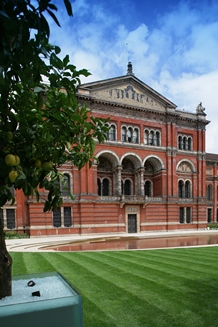The York-V&A Student Placement
The York-V&A student placement has a value of £1500.
The V&A
About the V&A
The Victoria and Albert Museum, as we now know it, was established in 1852, following the enormous success of the Great Exhibition the previous year. Its founding principle was to make works of art available to all, to educate working people and to inspire British designers and manufacturers. Profits from the Exhibition were used to establish the Museum of Manufactures, as it was initially known, and exhibits were purchased to form the basis of its collections.
The Museum moved to its present site in 1857 and was renamed the South Kensington Museum, later becoming renamed as the Victoria and Albert Museum. Its collections expanded rapidly as it set out to acquire the best examples of metalwork, furniture, textiles and all other forms of decorative art from all periods. It also acquired fine art - paintings, drawings, prints and sculpture - in order to tell a more complete history of art and design.
Today, the V&A has unrivalled collections of contemporary and historic art and design. It houses some of the world's greatest resources for architecture, fashion, photography, theatre and performance, sculpture, contemporary design, ceramics, Asian art and design, furniture, textiles, jewellery, metalwork and many more.
Read more about the history of the V&A on the museum's website: A Brief History of the Museum.
The collections
The V&A's collections cover most of the world's cultures, stretching from antiquity to the present. They are organised in seven curatorial departments:
- Asia
- Design, Architecture and Digital
- Furniture, Textiles and Fashion
- Sculpture, Metalwork, Ceramics and Glass
- Word & Image (incorporating the National Art Library, Prints and Drawings, Paintings and Photography)
- Theatre & Performance
- The Museum of Childhood
As well as the thousands of objects on display, the V&A’s reference collections include over two million more physical and digital objects, many of which are light-sensitive and so can only be displayed for short periods of time, which can be consulted on appointment. Many of these are housed at Blythe House, the V&A's study centre and off-site storage facility in Olympia. The site houses the Clothworkers' Centre for Textiles, the Theatre & Performance Collections, the Archives of Art and Design, and the V&A Institutional Archive.
[Information obtained / adapted from the V&A website]
The V&A is currently working towards a major expansion of its physical and digital reach, through its wide-ranging and innovative exhibitions and learning programmes, working nationally and internationally and opening state-of-the-art new galleries and facilities. In July 2017 the V&A opened the Exhibition Road Quarter, with a new entrance, courtyard and spectacular new temporary exhibition galleries, while other capital projects currently under development include a major new centre for Photography.
The partnership
The partnership
The Department has signed agreements with a number of local and national museums and galleries, including the V&A. The purpose of these agreements is to facilitate strong partnerships and share expertise with colleagues in these institutions. These partnerships contribute to the research and teaching culture of the Department of History of Art at York in many ways. Students and staff benefit from these collaborative links with collections of international importance. Curators and museum staff regularly visit York, we host joint seminars and events and work on collaborative projects.
The York-V&A Student Placement is an exciting element of the department's wider partnership with the V&A.
The placement
The York-V&A Student Placement is an open and flexible arrangement. The placement will grant the successful applicant privileged access to specific departments and/or collections of the V&A, according to their interests, and subject to negotiation with the V&A.The successful applicant will receive personal supervision by selected V&A staff. The Department of History of Art will offer additional support and academic supervision for the duration of the placement, as appropriate.
The shape and form of the placement is largely to be determined through individual agreements between the successful applicant and the staff of the V&A. It can take the form of training in collection management and curatorial work, or a hands-on object-based research project in preparation for the MA dissertation. The timing and frequency of the visits will also be subject to negotiation, but as guide we expect you to work full-time in the V&A for the month of May (after the end of your taught modules and before work on your dissertation begins in earnest) or the equivalent, depending on the specific need of the curatorial department you are affiliated to.
Applying
Eligibility
Studentship applications are welcomed from all full-time students, and part-time students in their second year of study, on the MA in History of Art, or a related pathway degree, regardless of fee status (Home, EU or Overseas).
How to apply
Please submit a short research proposal (of not more than 800 words) detailing your specific interests in the V&A's collection and what you can bring to this placement, personally and academically. The timing of the placement, and the length and frequency of visits, is negotiable with the V&A. Please email your personal statement to history-of-art@york.ac.uk by the deadline of 11am (BST) on Monday 21 October 2019.

